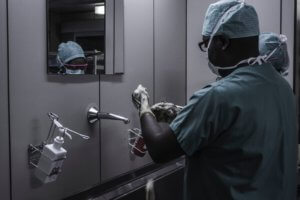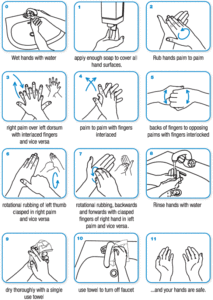The main purpose of washing hands is to cleanse the hands of disease-causing germs. This is especially important for people who handle food or work in the hospitals. Simple hand washing is superior to all other infection control measures. And now thhe world has come to learn this simple fact from the coronavirus outbreak that has turned the world upside down.
Antibiotics however potent they are not superior to hand washing in killing germs. With the emergence of nosocomial (hospital-acquired) infections, hand washing is taking on new urgency. No part of the human skin is spared from bacteria.
[the_ad id=”1146″]
To maintain good hygiene, hands should always be washed after using the toilet, changing a diaper or tending to someone who is sick; before eating; before handling or cooking food and after handling raw meat, fish or poultry. Germs are transmitted from unclean hands to food, usually by an infected food preparer who didn’t handwash after using the toilet. The germs are then passed on to those who eat the food.
Conventionally, the use of soap and running water and the washing of all surfaces thoroughly, including under fingernails is seen as necessary. One should rub wet, soapy hands together outside the stream of running water for at least 10 seconds, before rinsing thoroughly and then dry with a clean or disposable towel.
Also read: Indian foods to try this summer
Medical hand washing:

The purpose of hand washing in the health care setting is to disinfect bacteriae and to prevent transmitting them to another patient. Water alone is fairly effective, simply by removing any agent loosely adherent to the skin. Ordinary soap aids in the removal of all bacteriae. The proper washing of hands in a medical setting generally consists of the use of generous amounts of soap and water to lather and rub each part of one’s hands systematically. Hands should be rubbed together with digits interlocking.

To ‘scrub’ one’s hands for surgery, one requires a tap that can be turned on and off without touching with the hands. This procedure requires washing the hands and forearms up to the elbows, and one must in this situation ensure that all parts of the hands and forearms are well scrubbed several times.
When rinsing, it is ensured at all times that one does not allow water to drip back from the elbow to your hands. When done hands are dried with the sterile cloth and the surgical gown is donned.
Why is washing the hands important?

Ignaz Semmelweis (1818–1865)
Known as the “father of infection control”, Dr Ignaz Semmelweis was a Hungarian born physician who received his MD degree in Vienna in 1844. In 1847 he was given a 2 year appointment as an assistant in obstetrics with responsibility for the First Division of the maternity service of the vast Allgemeine Krankenhaus teaching hospital in Vienna.
Dr. Semmelweis demonstrated over a hundred years ago that routine handwashing can prevent the spread of disease. Dr. Semmelweis worked in a hospital in Vienna whose maternity patients were dying because they were treated by student physicians who worked on cadavers during an anatomy class before beginning their rounds in the maternity ward.
The students didn’t wash their hands between touching the dead and the patients. Handwashing was an unrecognized hygienic practice at that time. Dr. Semmelweis insisted that his students wash their hands and this reduced death rate remarkably. Handwashing is the single most effective way to prevent the transmission of disease. Semmelweis convinced a number of young faculty members who supported him.
In 1847, at the age of 28, Semmelweis famously deduced that, by not washing their hands consistently or well enough, doctors were themselves to blame for puerperal fever, the leading cause of maternal deaths in hospitals. On his wards, he mandated scrubbing with a nail brush and chlorine. The rate of death from puerperal fever immediately fell. Yet practices did not change. His colleagues were even offended by his claims: Far from being hailed, Semmelweis was dismissed from his job. In 1866 he died in a public insane asylum at the age of 47.
Hand washing prior to Semmelweis era was not liked by many. Prior to 1889 surgical gloves were not heard of and surgeons were operating with ungloved hand. Chemicals used to disinfect hands for surgery produced allergy. It was Caroline Hampton, surgical nurse of William Halsted of Johns Hopkins hospital who wanted a protective device to prevent this skin allergy. This prompted Halsted to request the Goodyear Rubber Company to manufacture thin gloves that will not interfere with necessary sensitivity during surgery.This was the birth of gloves and Caroline is credited as the first person to wear a surgical gloves. The surgeon responsible for the genesis is William Halste, who later married Caroline.
Remember, the good washing of hands and protective gloves can ward off many infections. Viruses are eliminated by washing but not by many antibiotics!!!
Also read: Planning a surgery this summer? Here’s what you need to know
